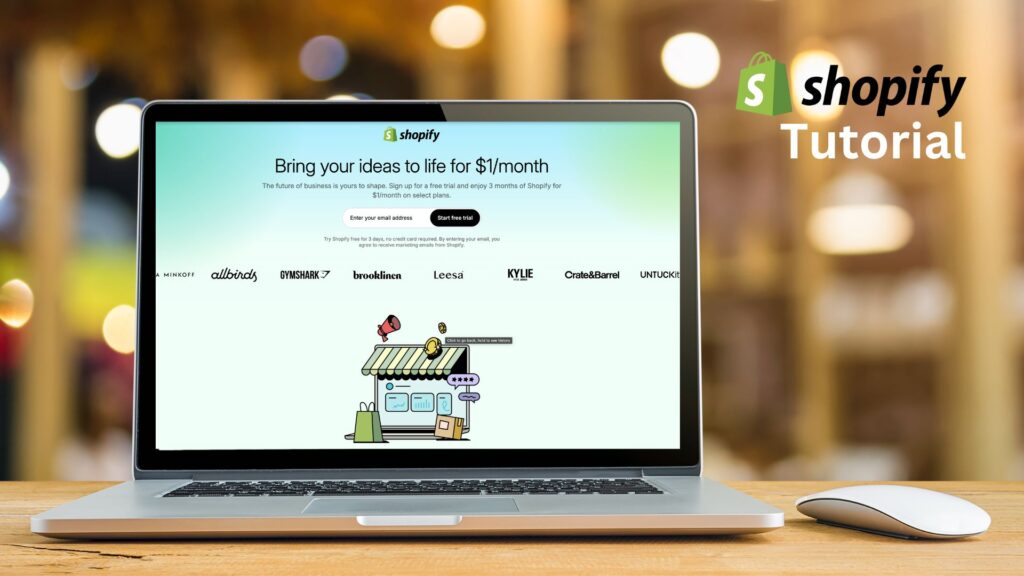If you’re new to Shopify and ready to start selling, one of the first things you must learn is how to add products to your store. Whether you’re launching your first product line, testing dropshipping, or building a print-on-demand brand, this guide will walk you through every step of the process.
This tutorial is based on the latest Shopify interface and is perfect for beginners who want to build a store that looks professional and converts visitors into customers.
Watch the full video tutorial on how to add products to your Shopify store.
Step 1: Set Up Your Shopify Store
Before you can add products, you’ll need a Shopify account. If you don’t have one yet, start with the free trial. Use the special link in the description to get your first 3 months for just $1/month after the trial.
Once you’re signed in, go through the onboarding flow. Answer a few setup questions, choose your store name, and enter your business details.
Step 2: Customize Your Store Theme
Before you add products, it helps to set the foundation with a clean store layout. Go to Online Store > Themes in the Shopify dashboard and choose a free or paid theme that fits your niche.
Customize the homepage, header, footer, and basic pages like About, Contact, and FAQ. You want your store to look trustworthy before adding inventory.
Step 3: Add a Product Manually
Head to Products > Add product. This is where you’ll enter all the core details for your product.
Here’s what to include:
- Title: Keep it clear and keyword-focused (e.g., “Custom Gold Name Necklace – Personalized Jewelry”)
- Description: Highlight features, benefits, and use cases. Be persuasive but simple. Use formatting like bullet points for readability.
- Images or Video: Upload high-quality visuals. Use mockups or real photos that show the product in action.
- Pricing: Enter your product price and compare-at price if you’re running a discount.
- Inventory: Add SKU numbers, manage stock levels, and choose whether to allow backorders.
- Shipping: Set product weight for shipping calculation. Indicate if it’s a physical product.
- Variants: If you sell different sizes, colors, or styles, you can add variants (e.g., Small, Medium, Large, or Silver, Gold, Rose Gold).
Click Save once your product is ready.
Step 4: Optimize Product SEO
Scroll to the bottom of the product page to find the Search engine listing preview section. Click Edit website SEO and customize the title and description for Google.
- SEO Title: Keep it under 60 characters. Include your product name and a main keyword.
- Meta Description: Aim for 150–160 characters. Explain what the product is and why it’s worth buying.
This helps you rank on Google and get free organic traffic to your product page.
Step 5: Create Product Collections
Collections help organize your store and make it easier for customers to browse.
Go to Products > Collections > Create a collection. You can create:
- Manual collections (you choose the products)
- Automated collections (Shopify adds products that match your rules, like tags or product type)
For example:
- “Best Sellers”
- “New Arrivals”
- “Gifts Under $50”
Once created, you can link collections to your homepage or navigation menu.
Step 6: Import Multiple Products at Once
If you’re adding a large catalog, you don’t have to do it one by one.
Two ways to bulk import:
- CSV File: Use Shopify’s product CSV template to upload products in bulk.
- Apps: Use apps like DSers, Zendrop, or Printful to import dropshipping or print-on-demand items with one click.
These tools pull product descriptions, images, and pricing, and even automate order fulfillment.
Step 7: Use Shopify Apps to Add Products Automatically
If you’re dropshipping or doing print-on-demand, Shopify has apps that make adding products effortless.
Here are a few beginner-friendly ones:
- Zendrop – Fast US shipping and branding options for dropshipping.

Starting from $39/month
50% off for 1 month
Key Features
Seamless dropshipping platform with fast shipping
Automated order fulfillment and tracking
Custom branding options for your products
Why We Recommend It
Zendrop makes dropshipping simple by automating order management and providing reliable, fast shipping. It’s perfect for entrepreneurs who want to focus on growing their store without dealing with complicated logistics
Pros & Cons
- Easy-to-use platform with automation
- Fast shipping to keep customers happy
- Custom branding to build your store's identity
- Limited to supported product suppliers
- Higher costs compared to manual dropshipping options
- Printful – High-quality print-on-demand products.
- Spocket – US and EU supplier options.
Starting at $24/month billed yearly
Start 14 day free trial
Key Features
Access to high-quality dropshipping suppliers, mainly in the U.S. and Europe
Fast shipping compared to traditional dropshipping platforms
Automated order fulfillment and real-time inventory updates
Why We Recommend It
Spocket helps dropshippers find reliable suppliers with faster shipping times, making it easier to run a successful online store without long delivery delays.
Pros & Cons
- High-quality products with faster shipping
- Easy integration with Shopify and WooCommerce
- Automated order processing saves time
- Some premium suppliers require a paid plan
- Limited supplier options outside the U.S. and Europe
Each app connects to your store, lets you browse their product catalogs, and adds items to your Shopify store in one click.
Final Thoughts: Add Products the Right Way
Adding products to Shopify isn’t just about filling in fields, it’s about creating a great shopping experience. Take your time with each listing. Use high-quality visuals, persuasive descriptions, and smart SEO.
Whether you’re uploading your first product or importing a full collection through an app, Shopify makes it beginner-friendly. And with tools like Zendrop or Printful, you can get started without holding any inventory.

